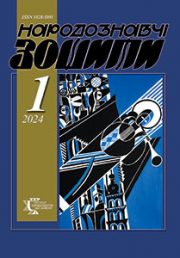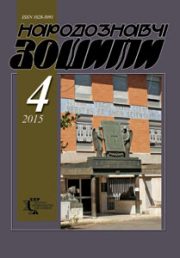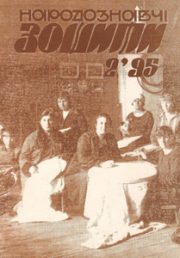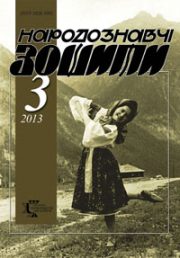The Ethnology Notebooks. 2019, № 4 (148), 1001—1006
УДК 398.8(=161.2):[7.043:582.711.712]
DOI https://doi.org/10.15407/nz2019.04.1001
ROZHA («ROUGE», «ROSE») IN UKRAINIAN RITUALISTIC FOLKLORE
SHEVCHUK Tetiana
ORCID ID: https://orcid.org/0000-0003-4856-4430
Candidate of Philological Sciences,
Senior researcher Institute of Art Studies,
Folklore Studies and Ethnology M.T. Rylsky
National Academy of Sciences of Ukraine,
4, Mikhail Hrushevsky st., 01011, Kyiv, Ukraine.
Contacts: е-mail: shevchuk1712@ukr.net
Abstract. This article deals with ethno-cultural features of the phytonym rozha («rose»), using as an example Ukrainian ritualistic folklore — charms against bleeding and the skin disease called rozha, kolyadkas (carols), vesniankas (spring ritual songs), Kupala, wedding and christening songs. The author devotes special attention to constant motifs of charms and Kupala songs: sowing (planting) of rozha, and of vesniankas and wedding songs: plucking (breaking) of rozha («rose»); and also, traces the relation of the rozha-rose to the semantic fields «fire», «blood» and «beauty». The original Ukrainian concept takes the beginning in folk Christianity — the birth of the Virgin Mary from a rozha flower — is mentioned as well.
The author»s attention was also drawn to binary Ukrainian folk names of rozha: «full rozha», «wild rozha», «black rozha», «red rozha», distinguishable for a certain semantic potential in the genre space of traditional culture. In their kolyadkas (traditional Christmas songs), girls sing mostly about a rose rouge, because of the dominant epithet «full». Kolyadkas about the Virgin Mary and infant Jesus are distinguishable for the richness of their shades of meaning: a rouge bursts into blossom above Mary, and a bird flies out of the rouge, signifying her newborn son. The epithets related to the color of ailment («white rouge», «black rouge», «red rouge») are typical for the folklore of both Western and Southern Slavs, and they can also be found in Polissian — Ukrainian and Belorussian — zagovory (verbal folk magic). The «rouge burning» motif in Ukrainian zagovory is semantically close to a Lithuanian ritual practice of treating the «rouge»: both the flower rouge and the ailment rouge are associated with fire. In zagovory, like in Kupala songs, the «red rouge» is associated with fire and blood. The «rouge sowing» motif is commonly found in the texts of Ukrainian Kupala songs, and today’s informants (Zhytomyr and Kyiv regions) attribute this motif to malva (mallow). In the second half of the 19th — early 20th century, complex symbolism of these songs was often explained in parallel with the ideas of mythology school (when «rouge» was associated with «live fire», i. e. lightning). The «rouge» of Ukrainian ritual folklore represents an embodiment of the greeting, vegetative power, beauty and youthfulness, revealing its rich semantic potential in traditional binary names of plants: «wild rouge», «full rouge», «black rouge», «red rouge».
Keywords: rose, folklore, symbol, charms, Mother of God, songs.
Received 14.06.2019
REFERENCES
Chervinskij, P. (2010). Rose in Dornen — to the interpretation of one romantic motive. Folklore and etymology (Pp. 330—337). Ternopil: Krok [in Russian].
Lysyuk, N. Mikhailo Maksimovich about symbolism of plant names in Ukrainian folklore. Retrieved from: http://nte.etnolog.org.ua/zmist/2004/N5/Art11.htm (Date of the application: 10.04.2019 ) [in Ukrainian].
Moskalenko, L. (2008). Areal variation of phytonomenes: coefficient of differentiation and types of differences (on the material of the Ukrainian steppe dialects of Mykolaiv region). Naukovyj visnyk Chernivecz`kogo universytetu (Issue 428—429, pp. 43—50) [in Ukrainian].
Erich, O.A., Beitl, R., & Beitl, K. (3 eds.). (1974). Dictionary of German folklore. Third edition. Newly edited by R. Beitl in collaboration with K. Beitl. Stuttgart: Alfred Krцner Verlag [in German].
Malinka, A.N. (1902). Collection of materials on Little-Russian folklore. Chernigov [in Russian].
Sosenko, K. (1994). Cultural-historical figure of the Old Ukrainian holidays of Christmas and Generous Evenings. Kyiv: SINTO [in Ukrainian].
Dlinna, T. (2012). Sotoryological aspects of the Mother of God on the Ukrainian folk-Christian tradition. Materials to Ukrainian Ethnology: Collection of scientific works (Issue 8 (11), pp. 30—36). Kyiv: Rylsky institute of Art Studies, Folkloristic and Ethnology of the NAS of Ukraine [in Ukrainian].
Bogaryrev, P.G. (2007). Folk culture of the Slavs. Moscow: OGI [in Russian].
Korol`, V. (2018). A handwritten collection of orders from the village Stebny`j of Rakhiv district of the Zakarpattia region. Folk Art and Ethology, 2, 110—113 [in Ukrainian].
Agapkina, T.A., Levkievskaja, E.E., & Toporkov, A.L. (Eds.). (2003). Conspiracies of Polesie (in the records of the 1970—1990). Moscow: Indrik [in Russian].
Zav’jalova, M.V. (1998). Semantic field «fire» in Russian and Lithuanian conspiracies. Balto–Slavyanskie issledovaniya 1997 (Pp. 374—391). Moscow: Indrik [in Russian].
Kolosova, V. (2001). The role of color in creating a symbolic image of a plant. Kodovi slovenskih kultura (Pp. 42—56). Boje [in Russian].
Chubinskij, P.P. (1872). Proceedings of the ethnographic-statistical expedition to the Western Russian region (Vol. 1, part 1). Sankt-Peterburg [in Russian].
Efimenko, P. (1874). Collection of Little Russian spells. Moscow: University Typography [in Russian].
ACMPR. F. 1—7. Od. zb. 723.
Passek, V.V., & Platonov, O.A. (Ed.). (2014). Sketches of Russia. Moscow: Institut russkoj civilizacii [in Russian].
Sumczov, M.F. (1918). Slobozhane. Historical and ethnographic intelligence. Kharkiv: Soyuz [in Ukrainian].
Amfiteatrov, A.V. (1904). Fabulous were: Old in new. Sankt-Peterburg: Obshchestvennaja pol’za [in Russian].
ACMPR. F. 14—3. Od. zb. 2.
Lesya, Ukrainka. (1977). Collected works: in 12 volumes (Vol. 9). Kyiv: Naukova dumka [in Ukrainian].







